Kozani,West Macedonia 作者: 来源: 发布时间:2021-07-13
I.Population and Area
Location within the region
Coordinates: 40°18′N 21°47′E
Administrative region West Macedonia
Regional unit Kozani
Districts 20
Area
• Municipality 1,071.3 km2 (413.6 sq mi)
• Municipal unit 366.0 km2 (141.3 sq mi)
Elevation 710 m (2,330 ft)
Population (2011)
• Municipality 71,388
• Municipality density 67/km2 (170/sq mi)
• Municipal unit 53,880
• Municipal unit density 150/km2 (380/sq mi)
Community
• Population 42,604 (2011)
• Area (km2) 34.371
Time zone UTC+2 (EET)
• Summer (DST) UTC+3 (EEST)
Postal code 501 xx (xx=31 or 32)
Area code(s) 2461
Vehicle registration KZ
Kozani is a city in northern Greece, capital of Kozani regional unit and of West Macedonia region. It is located in the western part of Macedonia, in the northern part of the Aliakmonas river valley. The city lies 710 metres (2,329 feet) above sea level, 15 kilometres (9 miles) northwest of the artificial lake Polyfytos, 120 km (75 miles) south-west of Thessaloniki, between the mountains Pieria, Vermio, Vourinos and Askio. The population of the Kozani municipality is over 70,000 people. The climate of the area is continental with cold and dry winters, and hot summers.
Kozani is the home of the University of Western Macedonia, with about 15,000 students from all over Greece and other places. It is also the seat of West Macedonia's court of appeal, police department, fire brigade, the seat of the 1st Army Corps of the Hellenic Army and of the Bishop of Servia and Kozani.
One of the most important aspects of local folklore is Kozani's carnival at the end of the winter, which retains much of the profanity of the ancient Dionysiac cult. Kozani is renowned in Greece and abroad for the production of Saffron (Krokos Kozanis), in the nearby town of Krokos
Kozani is a transport node between Central Macedonia, Thessaly and Epirus. The nearest airport is Filippos Airport, 4 kilometres (2 miles) from the city, IATA code: KZI. The airport was first opened in the mid-20th century. Kozani is situated near the Egnatia Highway, which connects the coast of the Ionian Sea with Thessaloniki and Turkish borders.
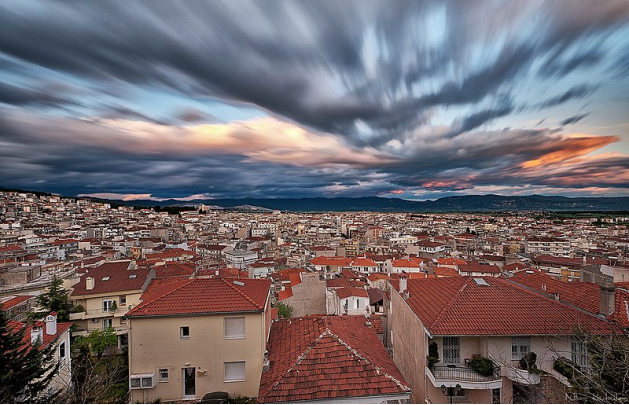
II.Natural Geography (environment and resources)
Climate
Under the Köppen climate classification, Kozani has a humid subtropical climate (Cfa). Rainfall is spread evenly throughout the year.
The climate of Kozani has changed over the years as a result of the environmental degradation brought by the extensive lignite mining in the area. The lignite mine is one of the largest in Eastern Europe; due to the constant expansion of the mining activities in the area several communities have already been moved closer to city of Kozani and more are scheduled to be moved by 2020. Given that the main source of income for the city of Kozani is the lignite mine and the thermal power station in the area local residents are often biased about the environmental catastrophe brought on by these activities.
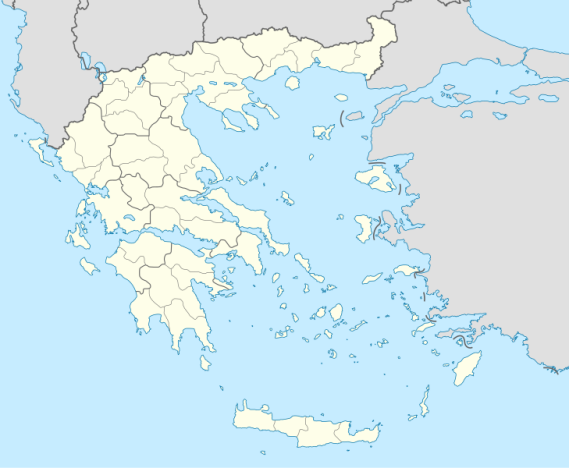
Transport
Kozani is accessed with Motorway Egnatia (or GR-2, or E90) from Ioannina and Thessaloniki, GR-3 (or E65) from Larissa and Florina, GR-4 and GR-20.
-- By bus, (KTEL Kozanis) for all West Macedonian towns and for the biggest Greek cities Athens (4 times/day - 470 km), Thessaloniki (every hour - 120 km), Larisa (120 km), Volos, Ioannina (160 km), Patras.
-- By aeroplane (Sky Express), the city is connected with Athens and Kastoria from Filippos Airport which lies 3 km (2 mi) south-east of Kozani.
-- By railway (OSE) to Thessaloniki (Railway Line Kozani - Amyntaio).
The public transit in the city is provided by minibuses, and between the centre and the municipal departments, it is provided by Transit buses. The traffic problems of the city have become more severe during the last few years.
III.Economy
Kozani - Arts, entertainment and recreation; other service activities; activities of household and extra-territorial organizations and bodies - Millions of euro (from 1.1.1999)/Millions of ECU (up to 31.12.1998)
89.50
in 2011
Arts, entertainment and recreation; other service activities; activities of household and extra-territorial organizations and bodies - millions of euro (from 1.1.1999)/millions of ECU (up to 31.12.1998) of Kozani increased from 53.2 in 2005 to 89.5 in 2011 growing at an average annual rate of 9.71%.
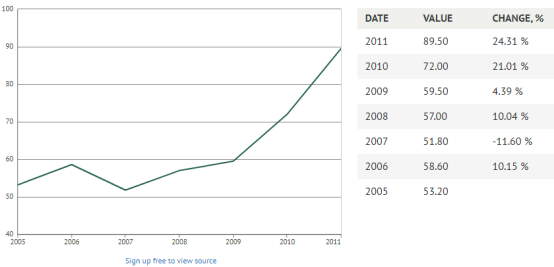
Kozani - Total - All NACE activities - Millions of euro (from 1.1.1999)/Millions of ECU (up to 31.12.1998)
2,930.10
in 2011
Total - all NACE activities - millions of euro (from 1.1.1999)/millions of ECU (up to 31.12.1998) of Kozani increased from 1,631.3 in 1997 to 2,930.1 in 2011 growing at an average annual rate of 4.37%.
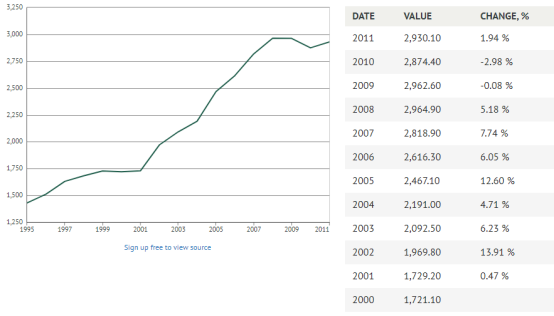
Kozani - Construction - Millions of national currency (including 'euro fixed' series for euro area countries)
70.40
in 2011
Kozani construction - millions of national currency (including 'euro fixed' series for euro area countries) was at level of 70.4 in 2011, down from 107.8 previous year, this is a change of 34.69%.
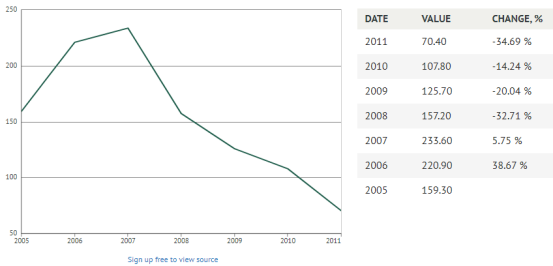
Kozani - Industry (except construction) - Millions of national currency (including 'euro fixed' series for euro area countries)
1,766.40
in 2011
Industry (except construction) - millions of national currency (including 'euro fixed' series for euro area countries) of Kozani increased from 1,271.6 in 2005 to 1,766.4 in 2011 growing at an average annual rate of 5.68%.
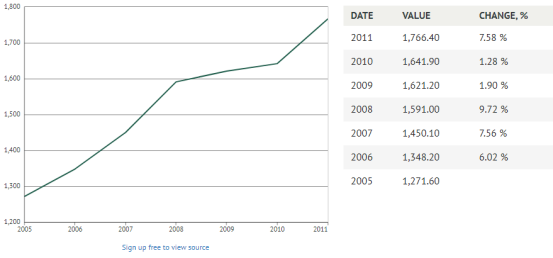
IV.Industrial Characterisitics
The city is mostly known for its important contribution to the Greek electricity supply, and a large part of the population works in the Public Power Corporation's Agios Dimitrios Power Plant, the largest power plant in Greece. The Ptolemaida Basin hosts the Western Macedonia Lignite Center, which is accountable for the production of 40%[citation needed] of the electric energy of the country.
Other famous products are marble, saffron (Krokos, Kozanis), fruits, local wines and specialized arts and crafts industry. The Commercial Exhibition of Kozani takes part in the Exhibition Centre of West Macedonia in Koila Kozanis every September. Many firms from Greece and other Balkan countries participate, especially with local products.
While Kozani remains a regional banking center, the Kozani-based Co-Operative Bank of Western Macedonia however failed the stress test conducted by the Bank of Greece and subsequently was liquidated in December 2013.
Mass media
There are some telecommunications companies, TV and radio stations, newspapers, magazines, and web portals based in Kozani. The television channels are West Channel, TOP Channel and Flash TV. Top-circulation newspapers include Chronos, Grammi, and Tharros.
V.Attractions
Downtown sites of interest
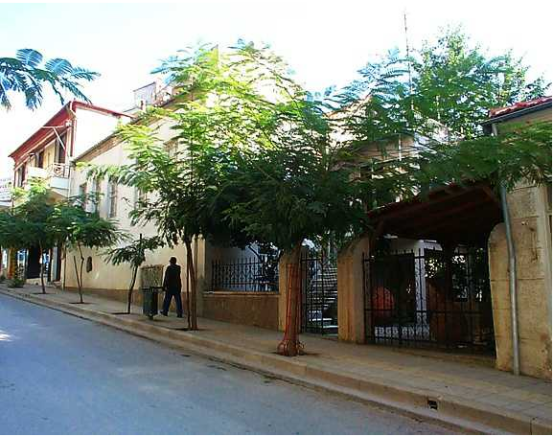
Archaeological Museum of Kozani view from outside
-- The Archaeological Museum of Kozani
-- The Historical–Folklore and Natural History Museum of Kozani is a place worth visiting. It is built according to old Macedonian architecture, and in its 6 floors, visitors can see everything about the geography, natural history, flora and animals of the region, as well as the history, the traditions and the past way of life in Kozani.
-- The Museum of Modern Local History of Kozani
-- The clock tower and the church of Agios Nikolaos - 350 years old - in Nikis Square.
-- Other attractions include the Grigorios Vourkas Mansion and the Georgios Lassanis Mansion. The second one lies in a central square, named Lassani Square and it is used as the Municipal Map Library.
Nearby sites of interest
-- The Municipal Park Kouri located in Agios Dimitrios where you can see the Cultural Center and the Municipal Theatre of Kozani, and the hill of Xenia with the nice view of all the city
-- The Museum of the Macedonian Struggle in Chromio, a museum dedicated to the history of the Macedonian Struggle.
-- Polyphytos bridge crossing the artificial Polyphytos lake. With a length of 1,372 m (4,501 ft), it is the second longest bridge in Greece after the Rio–Antirrio bridge.
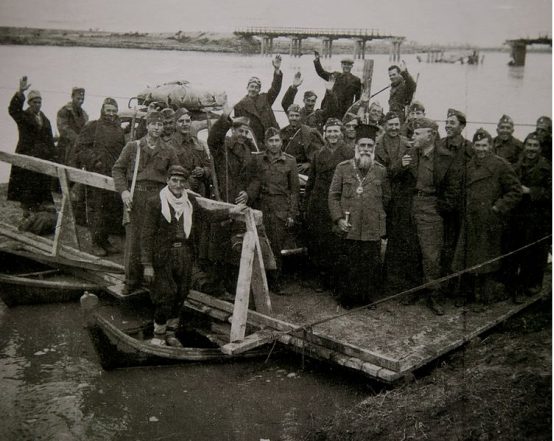
Metropolite Joachim of Kozani with guerillas of ELAS during WWII
VI.History
Antiquity
Antiquities from the prehistoric to the Byzantine period have been unearthed in many sectors of the city. In the east part of Kozani, an ancient necropolis has been found, dating to the early Iron Age. During Philip II of Macedon's reign, the region was named Elimeia, which was part of Upper Macedonia and probably in the same place there was a town named Tyrissa. In the south-west of the modern city, on Siopoto hill, there was a settlement named Kalyvia, between 1100 and 1300, traces of which are still preserved.
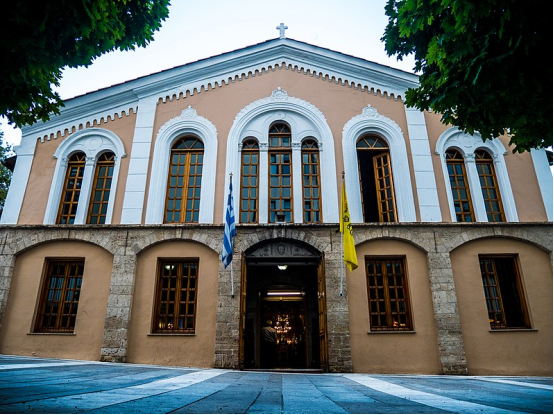
Saint Nicholas (Agios Nikolaos) church
Ottoman period
Kozani was probably founded by Christian settlers who, after the Ottoman conquest, withdrew from the plains of Macedonia into the mountains, during the 14th and 15th centuries. Its secure position soon attracted other Christians expelled from Epirus, in 1392. Together with the settlers from Epirus, many cattle-breeders moved in the region.
The first recorded mention of Kozani is in an Ottoman register of 1528, as a settlement with 91 houses, 23 singles and 15 widows. One of the most important colonizers of Kozani was the chief shepherd Ioannis Trantas, who settled about 100 families. His son, Charisios Trantas, managed to obtain a Sultan's firman in 1664, according to the terms of which the town came under the protection of the Sultan's mother, was endowed with many privileges, and became forbidden for the Turks to settle in.
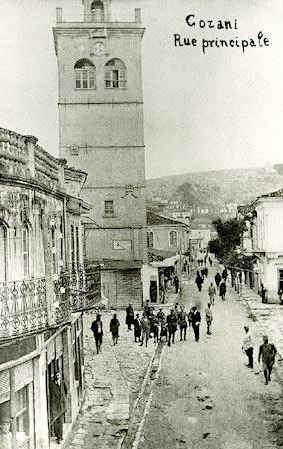
Agios Nikolaos' clock tower (Mamatsios), landmark of the city, in 1916.
In 1664, the magnificent church of Agios Nikolaos was built. In 1668, the library and the famous school of Kozani were founded. During the 17th and 18th century, commercial relations with the countries of central Europe gave the opportunity for the city to flourish economically. During the 19th century, as foreign travellers relate, the population of the town was Greek, and was growing (Leake 1835:305[12] and Bouè 1854:87).
The town's growth was disrupted in 1770, because of conflict that erupted between Kozani's local inhabitants and Kozanite merchants in central Europe, who contributed to the town's prosperity; even more catastrophically, the city was pillaged by Turkish beys in 1770. A subsequent incursion by Aslan bey, in 1830, ravaged the city immensely. In 1855 next to St. Nicholas Church a 26 meters high bell tower was built, which would become the symbol of the city. In 1939, a clock was added to the top of the tower, donated by Greek-American, Konstantinos Mamatsios. According to the 1904 population census, 12,000 Greeks and 350 Aromanians (Vlachs) were living in Kozani at the time.
In the late 19th and early 20th century, Kozani was part of the Manastir Vilayet of the Ottoman Empire.
Balkan wars
The Greek army entered Kozani on 11 October 1912, during the First Balkan War, after its victory against the Ottoman army in the Battle of Sarantaporo. By this time, the population of the town was 12,000 Orthodox Greeks. In 1923, during the population exchange between Greece and Turkey, about 1,400 Greek families from Pontus and Asia Minor were settled in Kozani.
Modern times
In the 20th century, the city grew tremendously, as lignite reserves in the area started being used by Public Power Corporation, making Kozani the foremost producer of electrical power in Greece. An earthquake that occurred in the region on 13 May 1995, with a magnitude of 6.6 on the Richter scale, caused only property damage.
The city now combines modern with old architecture. Some magnificent buildings are the clock tower, the town hall, the folklore museum, the "Valtadoreio" Gymnasium, the National Bank of Greece building, the "Ermioneion" Hotel and the mansions of Georgios Lassanis and Grigorios Vourkas. The Municipal Library of Kozani called "Kovendareios" is the second biggest in Greece, and it has 150,000 books, rare publications, valuable documents, and one of the rare copies of Rigas Feraios' charter. For this reason Kozani was included in the National Cultural Network of Cities with object the promotion of the Book and Reading. The Institute of Book and Reading was established and Kozani is now known as City of Books. Today Kozani is the administrative, commercial, economic, and transport centre of the region of West Macedonia.
VII.Other information
Etymology
According to prevailing opinion in Greece, the name comes from the village of Epirus Kósdiani, the origin of settlers of Kozani in 1392. The settlement was first named Kózdiani, which then, it was changed into Kóziani, and in the end into Kozáni.
Culture
Festivals and events
Kozani carnival is one of the most important events in the region, taking place at the end of winter. The dates change each year, depending on the start date of Lent. Carnival festivities in Kozani, and generally in Greece, last eleven days, starting on Tsikopempti (: Grassy Thursday, equivalent to Mardi Gras) and ending on Kathara Deftera (: Clean Monday, equivalent to Ash Wednesday).
During the Kozani carnival, great bonfires are lit in different parts of the city; every night, another district lights its fire and people dance around it; on the last night of the carnival, all fires are lit. These festive fires, as well as the cultural associations that organize the festivities in each district, are called Fanoi (fires). Each fanos welcomes visitors and locals to their district with songs and dances, and treats them to local delicacies, namely kichia (feta cheese wrapped around a snail-shaped phyllo) and meatballs, as well as wine. Popular songs are sung around the fire, with the singers and crowd dancing in a primitive way that sees repeating the same steps and gestures; at midnight, scatological and explicit songs are sung. In between songs, bands play instrumental songs, such as the Enteka, often called Kozani's "national anthem". In 2010, Theodoros Lakkas, one of the most prominent figures of the fanoi, lead singer of the fanos Lakkos t' maggan and writer of funny short stories, published the first anthology of Kozani's carnival songs, entitled Ivgati Agoria m stou chouro. This has been the first attempt so far to collect all the songs in one volume.
At the end of summer Lassaneia Events are organised. They consist of theatrical representations, concerts, athletic events etc. The name "Lassaneia" comes from Georgios Lassanis, who was from Kozani and participated in the Greek War of Independence. A part of those events is also the new authors song festival "Nikolas Asimos".
Niaimeros is a fair in the north of the city in the Niaimeros place. It takes place on the first Tuesday of October. It used to last 9 days (niaimeros = nine days), but now it lasts only 3 days.
Official local public holidays are the celebration for the liberation of the city from the Turks on 11 October and Saint Nicolas day - Kozani's patron - on 6 December.
The municipal Band is named Pandora. It was founded in 1902, and it takes part in all the events and celebrations.
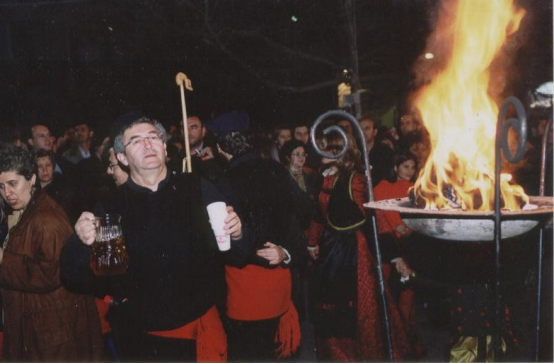
Fanos; an old carnival custom.
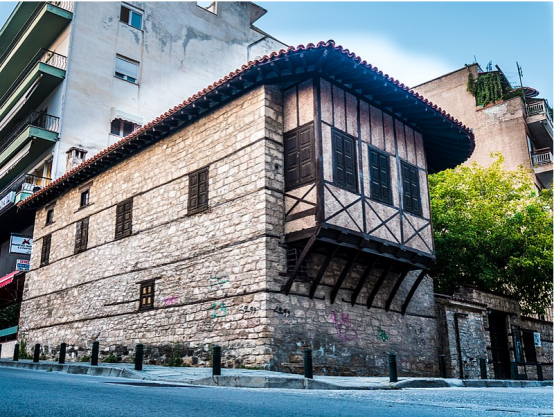
The mansion of Georgios Lassanis in Kozani. Today it is used as a Municipal Map Library.
Cuisine
A typical dish in Kozani is the so-called Yaprákia. The main ingredients are meat and rice in salty carbage-leaf, having the shape of an egg. It is used often as Christmas food. Kichí (Kozanitiko kichí) is another local dish, which is actually a cheese pie with circular-snail form.
VIII.Contact information
Mayor Lazaros Maloutas (KINAL; since 2019)
Kozani Municipality
Town Hall KOZANI , MAKEDONIA WEST , GREECE
1, Nikis Square 50100 KOZANI , MAKEDONIA WEST , GREECE
Tel.: +30 24613 50300 , Fax: +30 24613 50317
